Want to know how engaged your employees really are? Start with the right employee engagement metrics. You can’t improve what you don’t measure—and when it comes to team morale, motivation, and retention, the right data makes all the difference.
Just like psychologists rely on data, not assumptions, to understand human behavior, internal communicators need real signals to gauge employee engagement. You can’t rely on gut feeling alone.
Instead, modern internal communication tools give you access to measurable insights, like survey responses, email open rates, and feedback trends, that reveal how connected and motivated your workforce really is.
That’s where tracking the right employee engagement metrics comes in. This guide breaks down the top metrics for employee engagement, why they matter, how to track them, and what you can do to improve each one.
Take a self-guided tour of ContactMonkey
See how our key features can streamline your internal communications.
Take product tour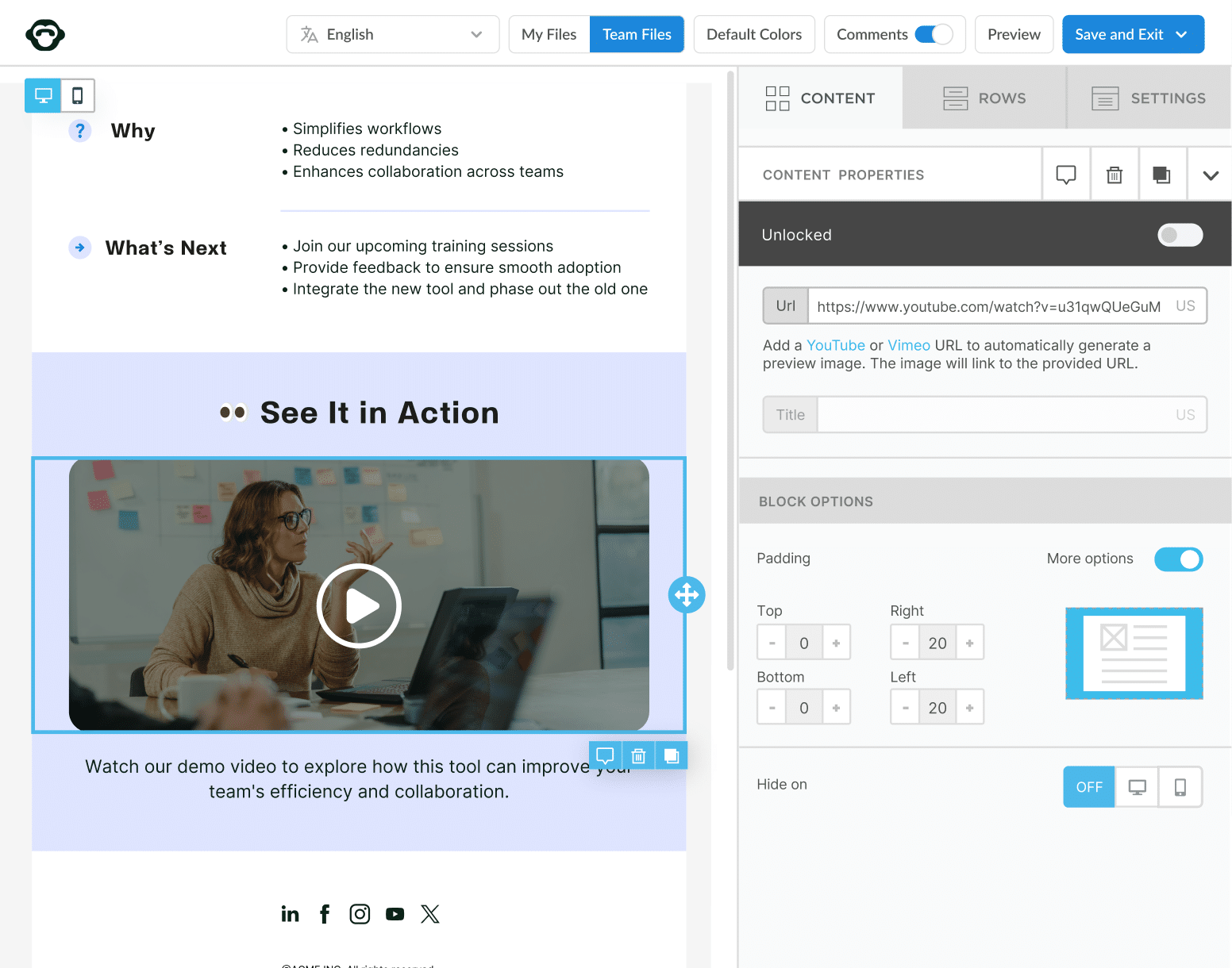
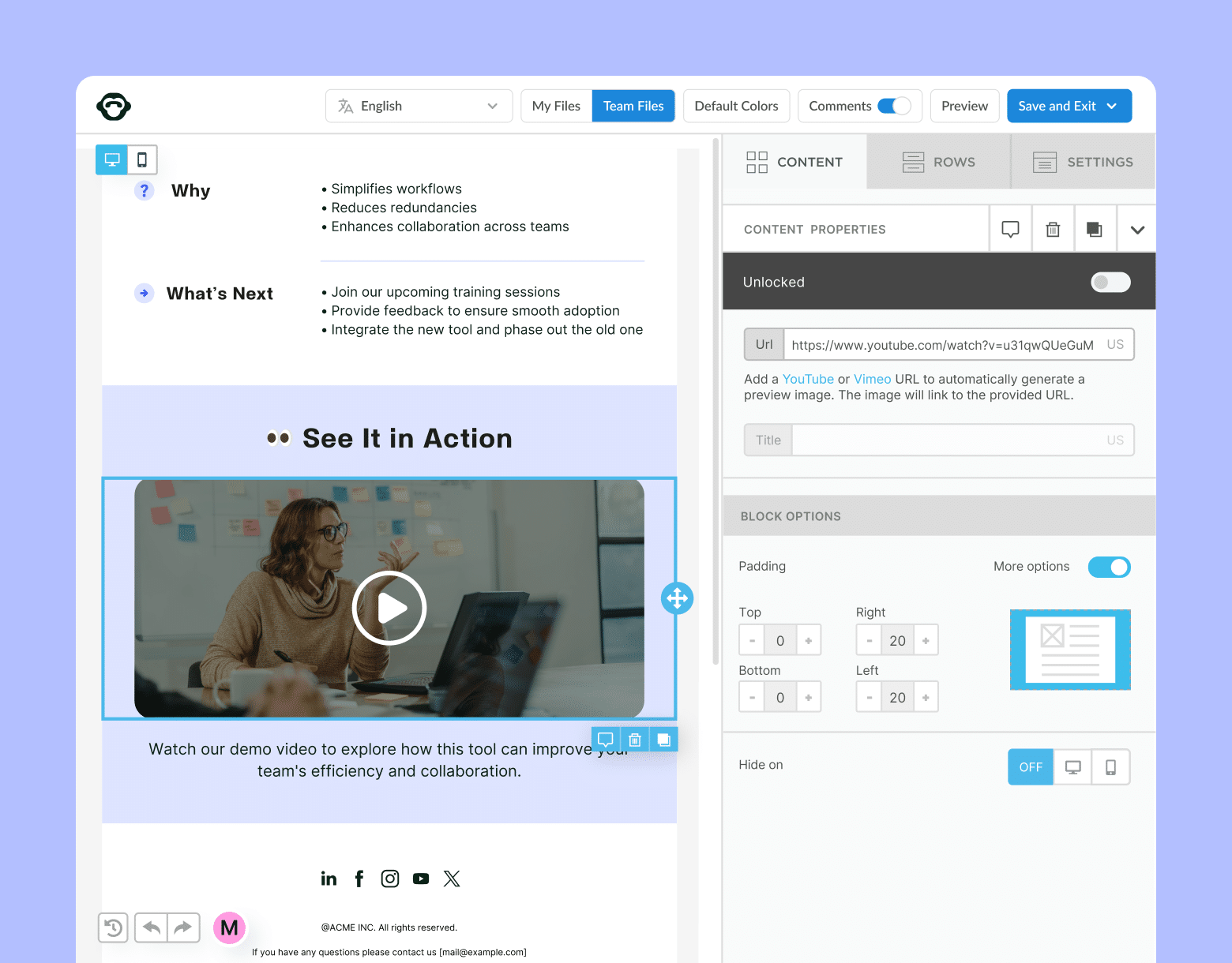
Why Tracking and Measuring Employee Engagement Is So Important
Engaged teams perform better. Period. But if you’re not measuring engagement, you’re missing the intelligence that helps you lead more effectively.
Employee engagement metrics don’t just show you where things stand—they offer real-time insights that help you course-correct, prioritize, and prove the impact of your internal communications.
Here’s why tracking staff engagement metrics is so important:
- Spot warning signs before they become costly problems (e.g. turnover or burnout).
- Quantify the impact of programs or initiatives.
- Make data-driven decisions to increase employee satisfaction and performance.
- Align engagement strategies with business goals.
In short, metrics for engagement help answer one big question: Are our people thriving—or just surviving?
Before you can increase engagement, you need to understand what’s driving it—or holding it back. And that starts with measuring the right signals.
What Are Employee Engagement Metrics?
Employee engagement metrics are measurable indicators that reflect how connected, motivated, and invested your people feel at work. These aren’t just about feelings—they’re about behaviors, patterns, and outcomes.
Some metrics are direct (like survey results). Others are indirect but equally revealing (like absenteeism or internal email open rates). The key is knowing which ones to track—and how to act on what you find.
Start two-way conversations and employee feedback loops
Learn how to engage staff with pulse surveys, content ratings and reactions, custom polls, and more. Ready to send modern emails?
See engagement features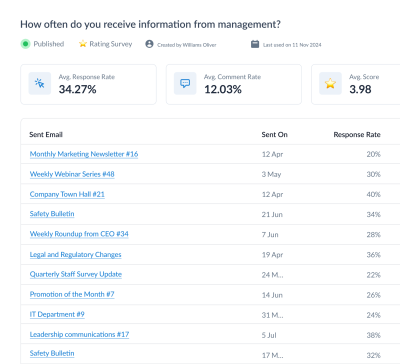
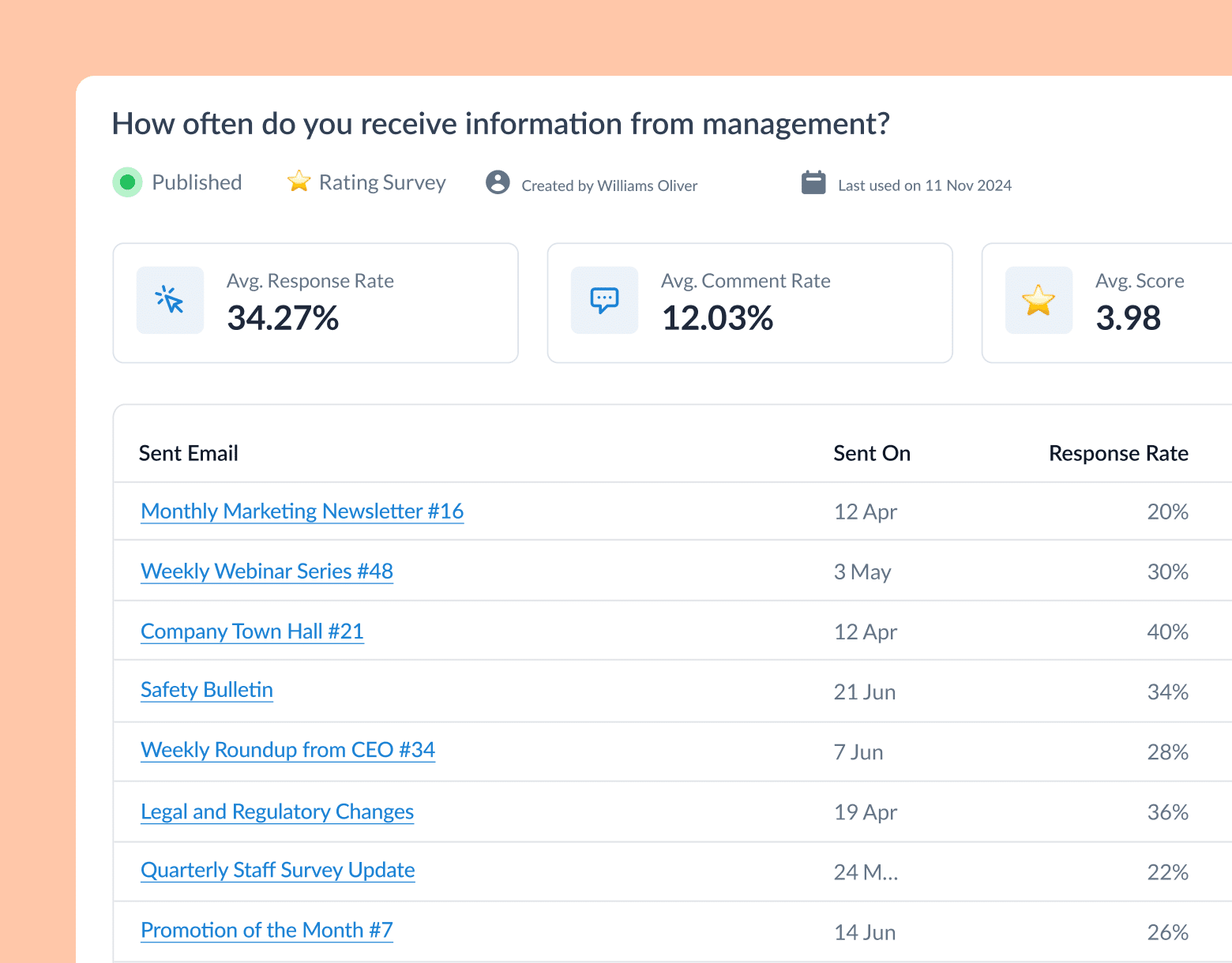
7 Essential Employee Engagement Metrics To Track, Measure, and Improve
Here’s your shortlist of the most valuable team engagement metrics for 2025 and beyond.
1. Employee Net Promoter Score (eNPS)
The eNPS is a quick way to gauge employee loyalty and advocacy. eNPS asks one core question: “On a scale from 0–10, how likely are you to recommend this company as a great place to work?”
Why it matters: A high eNPS means your team is engaged, loyal, and likely to speak positively about your organization. A low eNPS? That’s a red flag for disengagement or cultural issues.
How to measure this employee engagement metric: eNPS = % of Promoters (score 9–10) – % of Detractors (score 0–6).
Example: If 70% of employees are Promoters and 10% are Detractors, your eNPS = 60. Track this score over time, and compare results across teams, locations, or departments to identify engagement gaps.
How to improve this metric:
- Include an optional “Why?” follow-up question to uncover the reasons behind scores.
- Analyze trends by department, tenure, or job function.
- Share key findings with leadership and employees.
- Build an action plan that responds to recurring feedback themes.
PRO TIP: Learn how to use surveys in your internal emails and use ContactMonkey to automate eNPS collection, plus track trends over time.
2. Employee engagement survey scores
Employee engagement surveys provide the most direct feedback on how employees feel about their work, leadership, communication, and career growth. These surveys gather a mix of quantitative and qualitative responses to measure staff sentiment.
Why it matters: This is one of the most actionable employee engagement metrics. Survey scores give you a clear view into what’s driving or dragging down team engagement. The insights help shape HR strategies, leadership decisions, and workplace culture improvements.
How to measure this employee engagement metric: Use Likert-scale questions (e.g. “I feel valued at work” rated 1–5) to calculate average scores per category. Track trends over time across departments or locations.
Example of how to analyze this metric: If “trust in leadership” drops from 4.2 to 3.1 over one quarter, that suggests a loss of confidence and may point to recent decisions or communication gaps.
How to improve this metric:
- Ask more specific follow-up questions to understand root causes.
- Share results transparently with your team.
- Build an employee engagement survey results action plan with clear deadlines.
- Re-measure to track improvements.
PRO TIP: Use employee engagement software like ContactMonkey to send regular pulse surveys and analyze employee engagement analytics by audience segment. This helps track and optimize metrics for engagement in real time.
Watch ContactMonkey LIVE in action
Join live demo
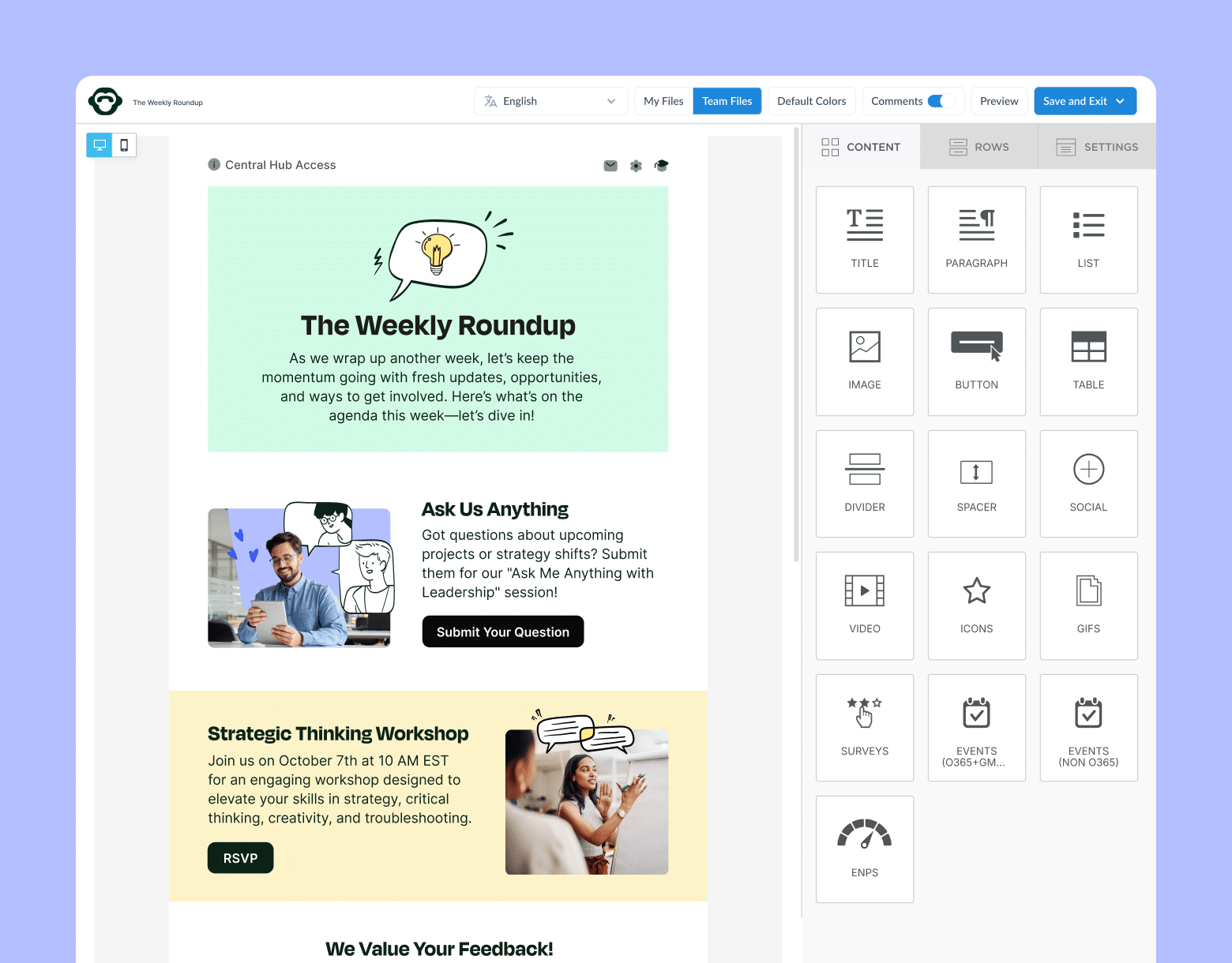
3. Internal email engagement (open + click rates)
Internal email performance is one of the most powerful staff engagement metrics. If your people aren’t opening, reading, or acting on what you’re sending, engagement suffers.
Why it matters: Email is still the primary communication channel for most companies. Tracking internal comms metrics like open rate and click-through rate gives you insight into content relevance, timing, and message clarity.
How to measure this employee engagement metric:
- Open rate = % of employees who opened the email.
- Click rate = % who clicked a link, answered a survey, or registered for an event.
Example of how to analyze this metric: If your open rate is consistently below 40%, try A/B testing subject lines, send times, and segmented lists to pinpoint what’s missing the mark.
How to improve this metric:
- Use segmented email lists to send targeted content.
- Schedule sends using timezone sending features.
- Write benefit-driven subject lines and use engaging visuals.
- Embed feedback surveys directly into the email.
4. Turnover and retention rate
Turnover tells you how many people are leaving. Retention tells you how many stay. Both are powerful employee engagement metrics because engaged employees tend to stick around.
Why it matters: High voluntary turnover is a sign of low engagement, burnout, or poor management. Tracking this helps you identify trends and intervene before top talent walks.
How to measure this employee engagement metric:
- Turnover rate = (Number of voluntary leavers ÷ average number of employees) x 100
- Retention rate = (Number of employees staying ÷ total employees at start of period) x 100
Example of how to analyze this metric: If one team has a 25% turnover rate while the company average is 10%, dig deeper into that group’s workload, leadership, or engagement scores.
How to improve this metric:
- Conduct stay interviews to understand why employees choose to remain.
- Use employee engagement surveys to spot dissatisfaction early.
- Prioritize internal mobility, career development, and recognition.
PRO TIP: Connect retention data to employee engagement analytics to pinpoint which teams or departments need urgent support.
5. Absenteeism rate
Absenteeism is a measure of how often employees miss work without scheduled leave. It’s a subtle but significant metric for employee engagement—because disengaged employees are more likely to call in sick or simply not show up.
Why it matters: Frequent absences hurt productivity, morale, and team dynamics. Tracking absenteeism can uncover deeper issues like burnout, poor leadership, or lack of motivation.
How to measure this employee engagement metric: Absenteeism Rate = (Total number of unscheduled absences ÷ total workdays) x 100.
Example of how to analyze this metric: A 5% absenteeism rate in one department vs. 1% in others suggests something specific needs addressing. It could be workload, management style, or unclear expectations within that team.
How to improve this metric:
- Monitor patterns by team, manager, or season.
- Use pulse surveys to explore causes (e.g., stress, workload).
- Offer flexible work arrangements or mental health resources.
- Provide access to mental health resources or Employee Assistance Programs (EAPs).
Get powerful email analytics and reporting features
Know exactly who is opening and engaging with your employee communications and company newsletters.
Explore analytics & reporting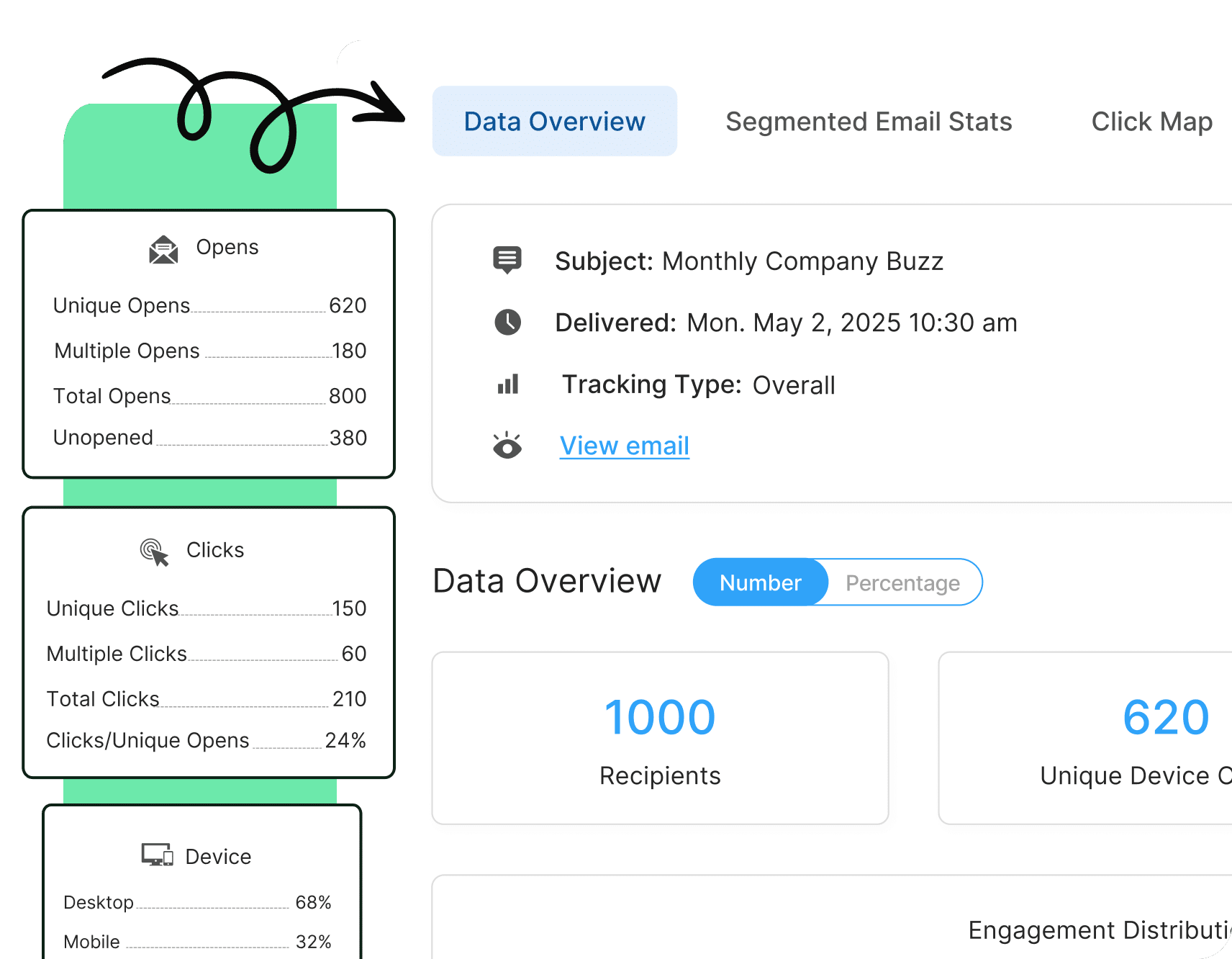
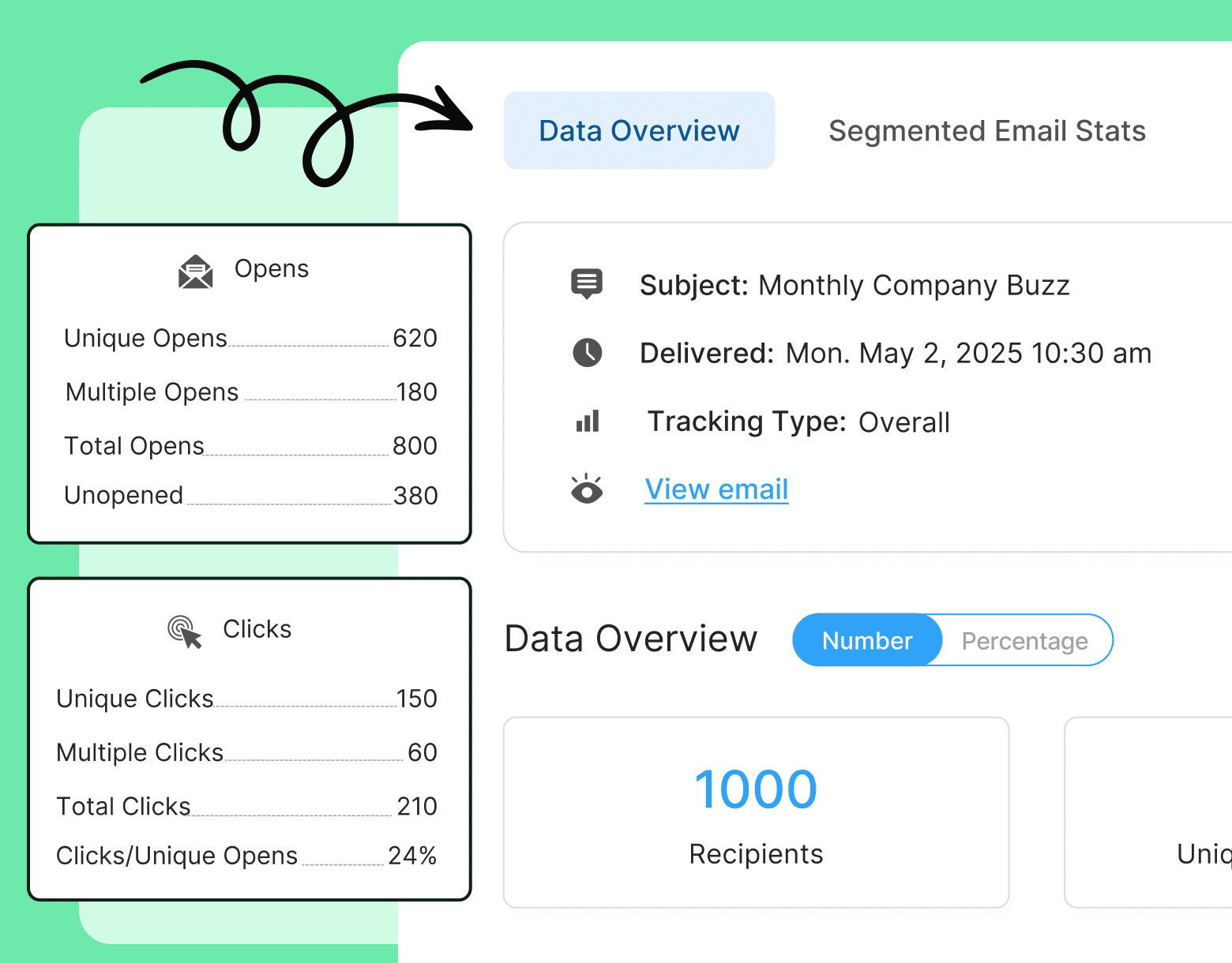
6. Employee participation rate
This is the percentage of employees who engage with your internal programs—like surveys, wellness challenges, company events, or recognition tools.
Why it matters: Participation is a direct reflection of how invested your people are. High participation = high engagement. Low participation = apathy, distrust, or communication breakdowns.
How to measure this employee engagement metric: Participation Rate = (Number of employees who participated ÷ total employees invited) x 100
Example of how to analyze this metric: If only 45% of employees attend a leadership Q&A session, consider whether the timing, format, or communication approach needs adjusting.
How to improve this metric:
- Communicate the “why” behind initiatives.
- Make participation easy (one-click RSVPs, mobile access).
- Incentivize participation with recognition or rewards.
- Share outcomes and actions taken.
PRO TIP: Tools like ContactMonkey can embed feedback forms and RSVP buttons into internal emails—making it easier to track participation across staff engagement metrics.
7. Recognition and feedback frequency
This metric tracks how often employees receive meaningful praise or feedback. Regular recognition is one of the most effective ways to increase employee engagement.
Why it matters: Lack of recognition is one of the top reasons people disengage or leave. Frequent, timely feedback builds trust, motivation, and a culture of appreciation.
How to measure this employee engagement metric: Use survey questions like “I receive recognition regularly” or track usage data from feedback tools and platforms.
Example of how to analyze this metric: If only 30% of employees report receiving recognition weekly, it’s likely affecting morale and signals a need for culture or manager training.
How to improve this metric:
- Train managers to give real-time praise and constructive feedback.
- Use peer-nomination tools for employee shoutouts.
- Schedule recurring recognition moments in team meetings.
- Set goals for feedback frequency in team OKRs or people-leader KPIs.
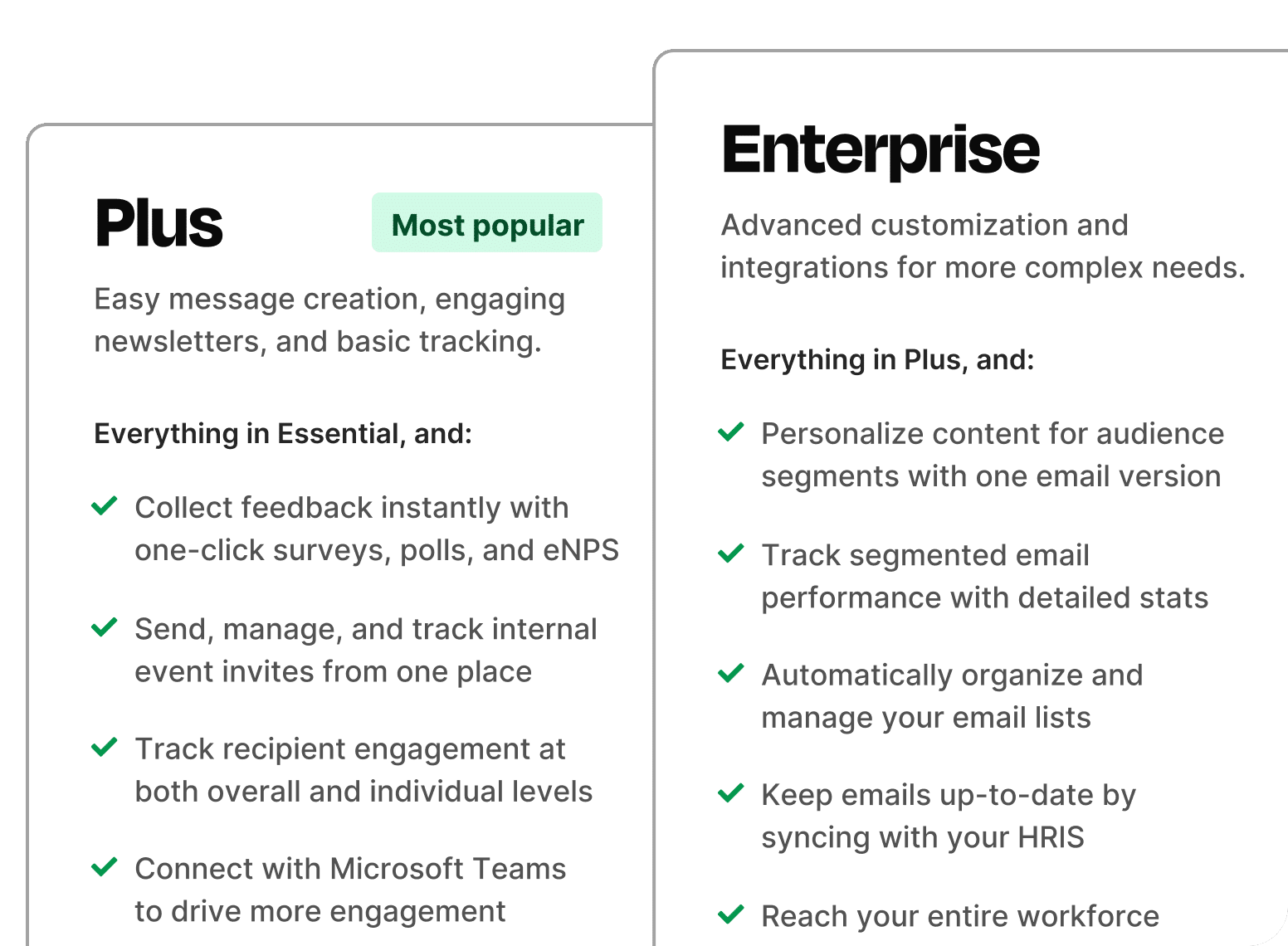
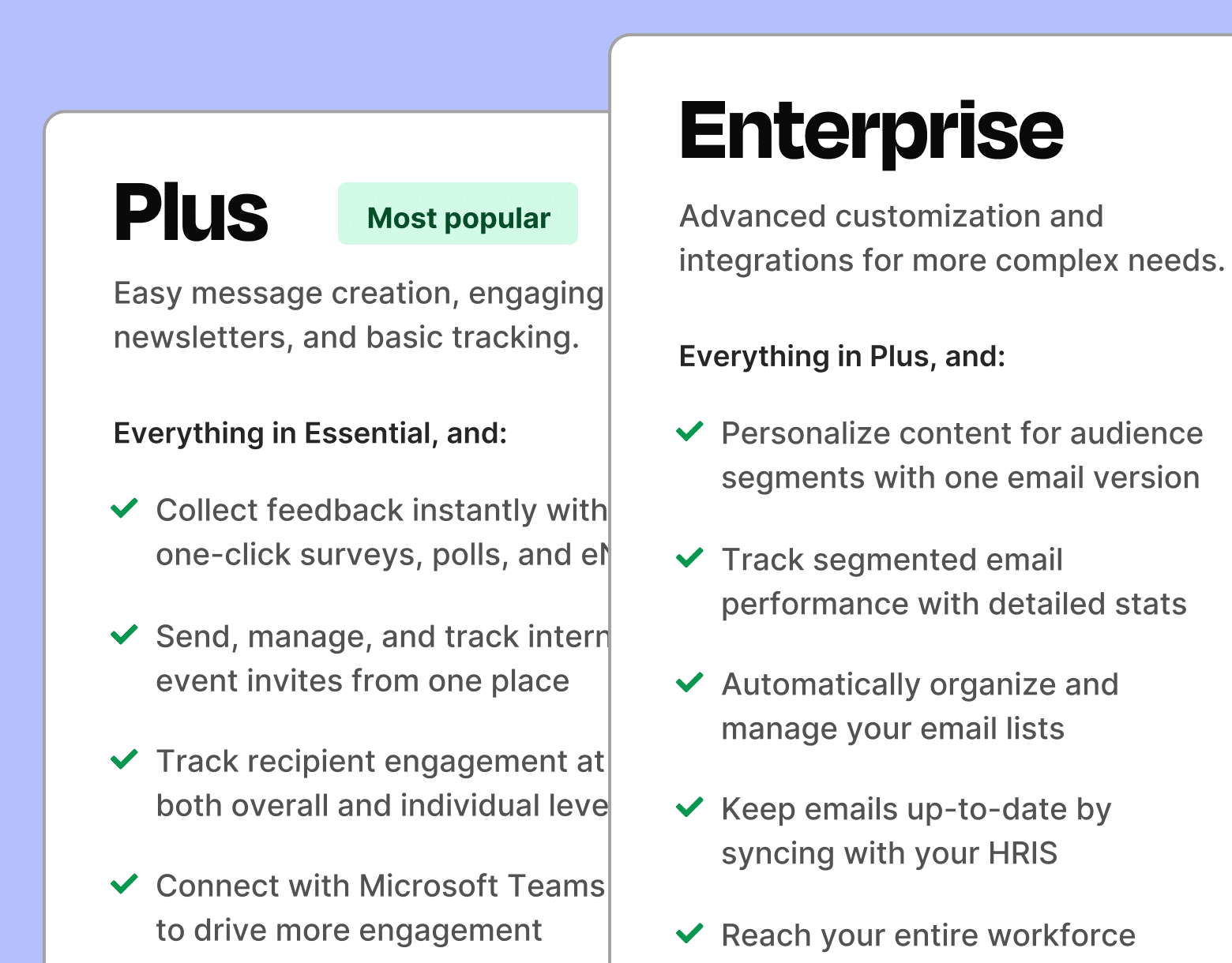
How to Best Use ContactMonkey for Employee Engagement Measurement
ContactMonkey makes it easy for internal comms and HR teams to move beyond guesswork—and start measuring what really matters.
Here’s how to use ContactMonkey to track, optimize, and improve your most important employee engagement metrics:
1. Send targeted employee engagement surveys
Use the Employee Feedback Features and access built-in employee engagement survey tools to send quick, mobile-friendly pulse surveys directly in Outlook or Gmail:
What internal communicators can achieve:
- Gather anonymous feedback.
- Track changes in sentiment over time.
- Measure engagement across teams, locations, or job levels.
Metrics you can track:
- eNPS
- Participation rate
- Sentiment across categories (e.g., trust in leadership, recognition)
2. Monitor internal email engagement in real time
Through the Analytics Dashboard Feature, track open rates, click-throughs, survey completions, and even scroll depth—without ever leaving your inbox.
What internal communicators can achieve:
- Identify which messages employees engage with most.
- Optimize timing, subject lines, and formats.
- Detect communication fatigue early.
Metrics you can track:
- Internal email open rates
- Click-through rates
- Scroll depth and interaction heatmaps
3. Segment audiences for more personalized insights
Use our List Management Feature to create custom distribution lists—like managers, new hires, remote employees, or teams.
What internal communicators can achieve:
- Personalize communication to different employee groups.
- Compare engagement across departments or locations.
- Deliver more relevant content that drives interaction.
Metrics you can track:
- Team-level eNPS.
- Departmental survey scores.
- Segment-based email engagement.
4. Automate feedback collection in your email templates
Embed pulse surveys, emoji reactions, and comment boxes directly into your internal newsletters and email templates with the Email Template Builder Feature.
What internal communicators can achieve:
- Increase real-time feedback without sending separate surveys.
- Make feedback frictionless for employees.
- Capture emotional sentiment alongside engagement.
Metrics you can track:
- Feedback frequency
- Qualitative sentiment (via comments)
- Real-time interaction rates
5. Close the loop with “You Asked, We Delivered” follow-ups
Send updates that show employees exactly how their feedback led to change, all from the same communication channel they already use.
What internal communicators can achieve:
- Build trust by showing action.
- Reinforce a culture of transparency and responsiveness.
- Boost future participation in feedback initiatives.
Metrics you can track:
- Improved eNPS.
- Increased participation in surveys or events.
- Positive sentiment change in follow-up surveys.
Whether you’re looking to improve open rates, capture real-time feedback, or prove the ROI of your internal communications, book a 15-minute call with one of our experts to see exactly how you can measure employee engagement.



